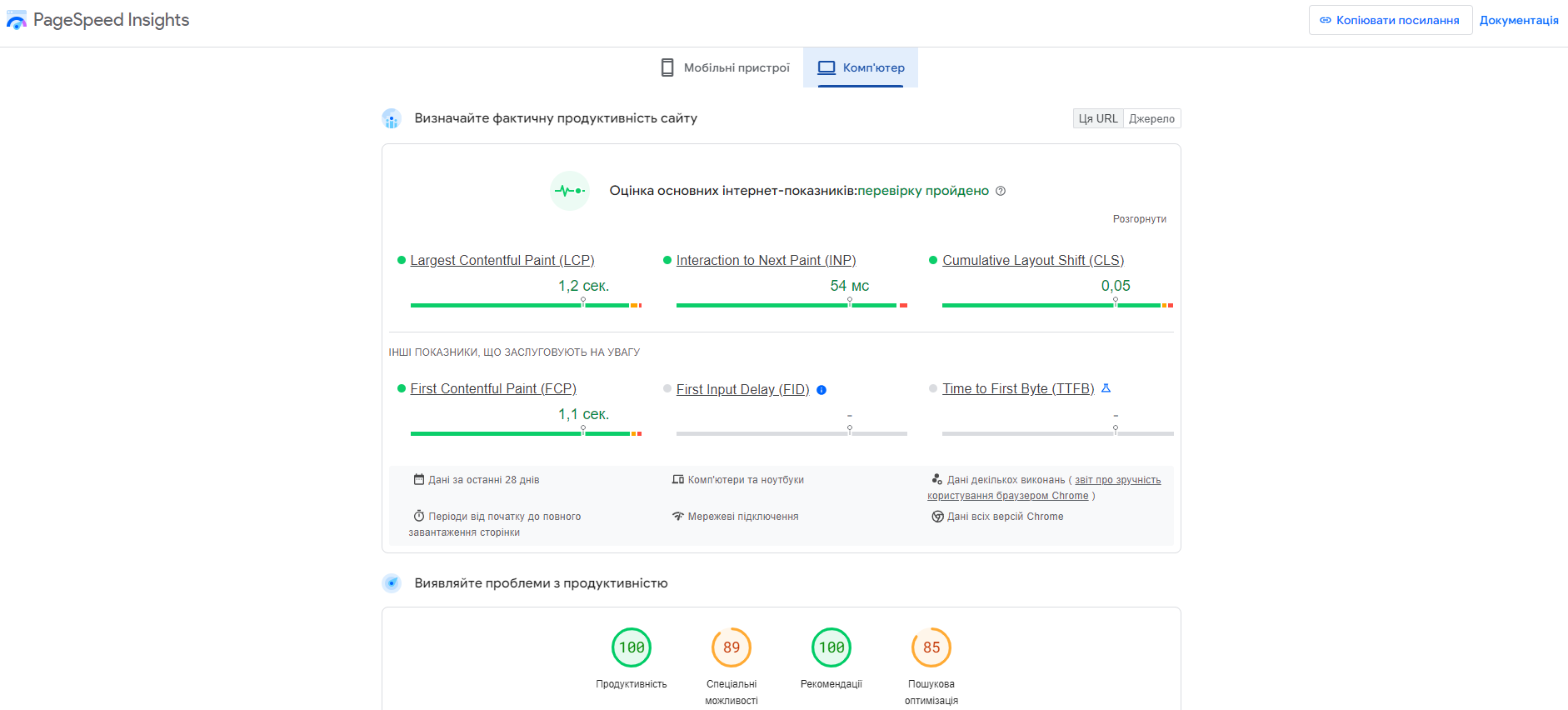Content of the article

Behavioral factors are metrics that evaluate how users interact with a site. They help determine how convenient the resource is to use and how effectively it provides the necessary information.
These factors play an important role in website ranking. If users actively visit a site, stay on its pages for a long time and find useful information, this is a signal to search engines that the site meets the expectations and needs of users. As a result, the site rises higher in search results. Otherwise, if the site does not satisfy the needs of visitors, its ranking may decrease.
The BF includes the following indicators:
- Total page traffic
- Failure rate
- View depth
- Direct calls
- Conversions
- Brand traffic
- Download speed
- Mobile version
Below we will consider each factor in more detail.
Total page traffic
This factor primarily shows how many visitors came to the page. After all, if a page is rarely visited by users, search engines may regard it as uninformative and send it to the very bottom of search results. Conversely, if a page receives a large amount of traffic, it will receive more attention from search engines. Therefore, the analysis of behavioral factors should begin with total attendance.
Failure rate
Having looked at the general traffic of pages, the failures of visitors immediately catch your eye. So what are site failures? Failures on a website are considered to be when a visitor leaves the site too quickly, without completing the target action. Bounce Rate for Google this is viewing only one page. But don’t panic too much about a high bounce rate, because the norm for each niche may be a different percentage. What could be the reason for the high failure rate?
Let’s look at the most common reasons:
- The page content is not relevant to the user’s request. What often happens is that a visitor is looking for sunglasses, but the page sells swimming goggles. Accordingly, the visitor understands that these are not the right glasses and leaves the page, thereby increasing the abandonment rate. To avoid this misunderstanding, you need to collect the correct semantic core and cluster it well, and then composes the appropriate meta tags.
- Site appearance. As they say: “You meet people by their clothes.” After all, if the site has blurry pictures and the text is written in a different style, and even on a bright red background and in small font, then there is a very high probability that the visitor will leave immediately.
- The material presented is not very high quality. For example, the site describes a method for sewing shoes, and it says: “Take a thin nylon thread,” which seems to be very good. But, if you indicate the thread marking (187tex*12) plus a photo of the skein or packaging, then the reader will understand everything and continue reading.
- The content is presented very briefly and with high quality. If you have briefly outlined the essence of the description of the service, and the visitor can understand everything in a few seconds, then you can add a feedback form or “Buy with this”, or “We have more…”, then there should be a link on this page. You can also add high-quality photographs, calculators, an image of a person walking on the side while scrolling, etc. All this can hold and push a person to take the target action.
- Poorly designed 404 page. There are times when you need to remove a page from the site (you stopped working with this manufacturer), but this page has not yet fallen out of the index. A visitor comes to a non-existent page and sees the inscription: “Page 404. You may have made a mistake when entering the address” and that’s all. After all, a person has already come to your site, and you need to keep him and, ideally, achieve the target action. To do this, you need to design a 404 page in the style of the site, so that there is a header, a footer, plus good text. Example: “Sorry, this page does not exist. You may be interested in products from our catalogue” and make the word “catalogue” a link to the catalogue.

View depth
Browsing depth refers to the average number of pages visited by a user. This indicator is inversely related to the number of bounces: the fewer bounces, the higher the viewing depth, and vice versa. The higher the indicator, the better for the resource.
How can you increase this value:
- High-quality linking. It will attract the user to view other pages of the site. The most addictive site is Wikipedia, you can spend a lot of time there.
- Clear interface. It should be easy and comfortable for the user to find the desired content on the site.
- The material is divided into parts by subheadings so that the user understands whether there is any point in further reading the article.
Direct calls
Direct visits are a visit to a site in which the visitor enters the site URL into the address bar of the browser. First of all, this indicates that the user knows this resource and is not accessing it for the first time. This also means that the resource is already recognizable on the Internet and the brand is quite popular. The number of direct visits reflects the number of regular customers.
How to increase the number of direct visits to the site:
- Place a button with the “Add site to bookmarks” function in a visible place.
- Create content that users will return to regularly (for example, reference materials).
- Develop free online tools such as a calculator or order tracking system.
- Add a QR code with a link to the website for offline advertising (flyers, banners).
- Analyze what content is most attractive to regular users and publish it more often.
Conversions
Conversions on a website are the completion of a targeted action by a user on a specific resource.
Target actions can be:
- Click on the phone number.
- Click on email.
- Placing an order.
- Leaving a review, etc.
Low percentage conversions clearly shows problems with behavioral factors: users do not perform targeted actions – when moving through the pages of the site, they do not fill out forms, do not add products to the cart, and do not place orders.
The reasons for this may vary and are not always related to behavioral factors. For example, if your products are more expensive than your competitors, behavioral factors will not help much. Only under equal conditions will work on behavioral factors be able to increase sales through the site.
Brand traffic
Branded traffic is transitions to a website based on requests with the name of a company, brand, or website address. If branded traffic grows, then your resource becomes more popular online among the target audience.
How to increase brand traffic:
- Managing communities on social networks.
- Crowd marketing.
- Offline advertising.
- Content marketing and blogging.
- Mention of the brand and product on third-party sites, increasing the link mass.
- Placing information in catalogues, directories, aggregators and on maps.
Download speed
Website loading speed is one of the most important BFs, since now people value their time. Most users won’t wait longer than 5 seconds, especially if it’s a new site that can easily be replaced by a competitor. And if the site takes a long time to load, users will simply leave. By going back to search from your resource, visitors lower the behavioral factors of the site and give preference to competitors.
For site speed checks Google’s PageSpeed Insights service is most often used, but for a complete understanding it is better to use several services. It is advisable to increase the site loading speed to the green indicator, both in the mobile and desktop versions.

Optimize your download speed:
- Reduce the size and weight of images.
- Improve your HTML code.
- Make your website responsive for mobile devices and compatible with different browsers.
Mobile version
A mobile version or adaptive version of a website is a version of a resource specially designed for correct display on mobile devices. It’s no secret that we spend most of our time on gadgets. Accordingly, in order for the site to be visited from mobile devices, there must be mobile version. Its presence or absence now affects almost everything – from traffic to conversions. And for behavioral ranking factors too.
When a user accesses a site from a mobile device, and the site is not adapted for it, he encounters problems: buttons and text are too small, nothing can be seen or understood. This causes irritation, and the user goes to a competitor’s site, where everything works correctly. As a result, this leads to a large number of refusals and a small number of orders.
All functions of the desktop version should be available on the mobile version.
What is important to remember
Ranking factors are analyzed in aggregate. Search engines take into account many different parameters when generating search results, so site optimization must be carried out comprehensively. You won’t be able to improve your site’s position by improving just one aspect, for example, loading speed.
The exact influence of factors on ranking remains unknown. Search engines don’t reveal which ones have the most impact. Estimates by SEO experts may vary, with behavioral factors believed to contribute between 20% and 50%.
The significance of the factors may vary. Search engines regularly update their algorithms, which changes the principles of search results.
To summarize
By checking all the above points at least once a month, you can make your website very user-friendly, thereby maximizing behavioral factors and raising your website to the first lines of search results. If there are difficulties with analyzing or setting up the necessary elements on the site, we strongly recommend that you contact proven SEO specialists. Improve your website and get to the top of search engine results!






 03/06/2024
03/06/2024  3264
3264



